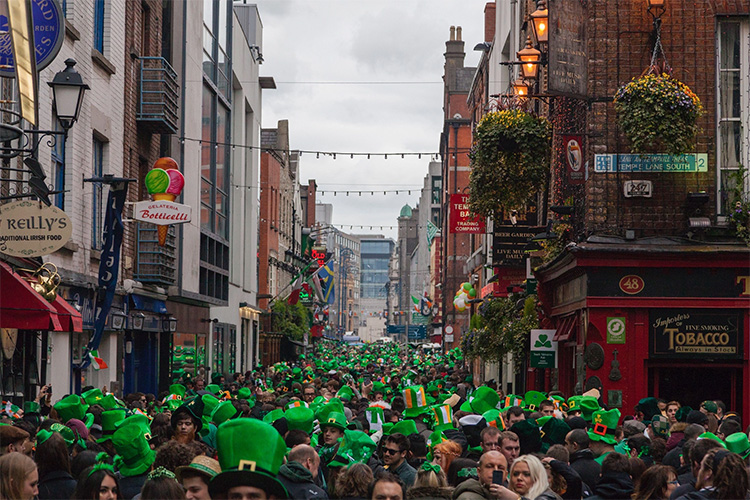
Hundreds gather each year for Saint Patrick’s Day parades all across the world. photo by Olivia Waxman
Saint Patrick’s Day is widely regarded as an Irish holiday, but most of the familiar traditions are actually American- this is what happens when different holidays join America’s cultural melting pot.
It’s that time of year again, where big chain stores like Target and King Soopers cover their shelves in green. Four leaf clover decorations, little pots filled with gold, and other similar items pop up in store fronts. McDonalds brings back their infamous shamrock shake, elementary schools show their students how to build leprechaun traps, Chicago dyes its river an electric shade of green. Perhaps the most prominent of all, breweries see a boom in business as people come in to celebrate.
It’s March, and Saint Patrick’s Day is coming up. Statistically, it isn’t the most popular holiday among Americans, though it can be seen nearly everywhere. When people think of Saint Patrick’s Day, they think of four leaf clovers, leprechauns, pots of gold, alcohol, corned beef and cabbage, and lots of green. But most of these familiar traditions were born in America, not Ireland.
For a long time in Ireland, Saint Patrick’s was treated as a more holy day – a religious celebration to commemorate the death of Saint Patrick, the missionary who was credited with bringing Christianity to Ireland. It was a solemn day, seen with Catholics walking to their churches and partaking in a feast in the afternoon. No parades occurred, no stores sold bright green foods, and clovers weren’t hung on every wall.
The first celebrations occurred among American colonies during the early days of the country. In 1737, dozens of Irish immigrants and Presbyterians came together to honor the Saint. They also formed the Charitable Irish Society in order to help struggling Irish immigrants. The organization is now known as the oldest standing Irish organization in America as of today. They still hold an annual dinner every Saint Patrick’s Day. In 1762, Irish born members of the British Army marched through lower Manhattan to a local Saint Patrick’s breakfast to celebrate.
These celebrations raised trouble from groups of nativists and anti-catholic mobs. The groups soon began their own tradition, dressing statues and dummies in rags and stringing potatoes around the necks. They would put whiskey bottles in the hands and pockets of the effigies and put them up on streets and other public places on the night before Saint Patrick’s as an attack on Irish-Americans and Irish immigrants. This practice was later banned in 1803.
The celebrations of the holiday continued their annual appearances in America, but really began to pick up speed when the Potato Famine began in 1845. Irish Catholics and refugees flooded the country and it was around this time that the holiday gained a newer meaning among immigrant groups. It became a celebration of being Irish, and parades appeared as a way to show strength against nativism.
Traditions that are popular today, such as the “staple” meal, corned beef and cabbage, all originated among Irish immigrants in America. Corned beef proved a cheap substitute to ham, which was more common back in Ireland. For immigrants suffering from the effects of poverty and living in lower Manhattan’s slums, the leftover salted provisions were only a penny a pound, and soon became a staple among households.
As immigrants began to assimilate into the country, those without Irish blood joined the celebrations, taking on the newfound traditions and participating in large parades. It wasn’t until around the 1960s that Ireland took on America’s Saint Patrick’s Day traditions. Pubs began to stay open on the holiday, and then later in 1996, Dublin introduced their first multi-day Saint Patrick’s Festival. Today, the festival attracts nearly one million people annually.
Saint Patrick’s Day has gained plenty of significance over the centuries. Often, America is described as a melting pot of different cultures and traditions, and Saint Patrick’s Day is a prime example of how celebrations from other countries can adopt different meanings here. Today, the holiday is celebrated in plenty of ways in many countries, and it still holds important meaning for Irish-Americans – even if it does mean that yearly show of unsettlingly green food at every chain restaurant.